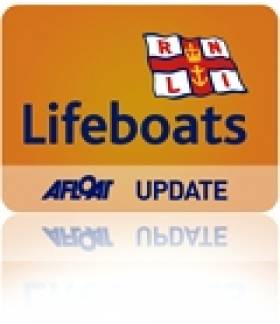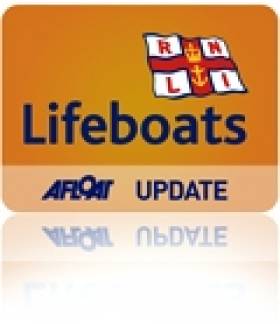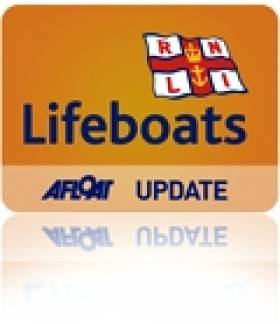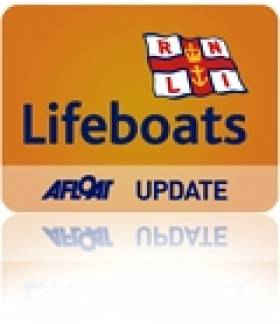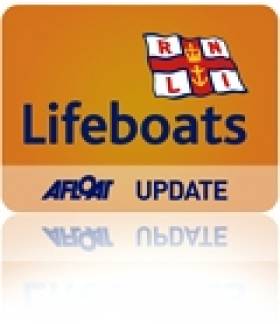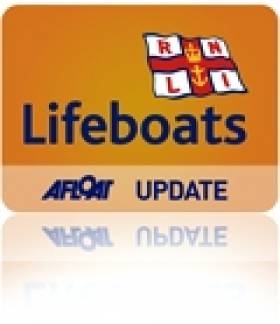Displaying items by tag: Lifeboats
Howth, Kilrush Lifeboats Launch In Gale Force Winds At Weekend
#RNLI - Howth RNLI has brought six people to safety on Saturday evening (2 November) after their 37ft yacht got into difficulty north of Dublin Bay.
The volunteer crew was requested to launch their all-weather lifeboat by the Irish Coast Guard shortly after 6pm following a report that a 37ft yacht was unable to safely enter the harbour from one mile east of Howth Harbour.
The lifeboat, under coxswain Robert Duffy and with six crew members onboard, launched in five minutes into gale force winds and made its way to the scene.
Weather conditions were difficult, with winds blowing Force 8 to 9 at the time and gusting to 45 knots.
The lifeboat located the yacht in a calm, sheltered bay off Howth Head. A lifeboat crew member was then transferred to the disabled boat which had encountered a mechanical problem. A tow line was then established and the lifeboat brought the vessel to safety at Howth at 7pm.
Speaking following the call-out, Duffy said: "This was a challenging call-out for our volunteer crew tonight given the gusty weather conditions and the darkness.
"Thankfully we were on scene quickly and using our training, we were able to assist the six crew members on board the yacht and bring them safely to shore."
Elsewhere, Kilrush RNLI brought a yacht which was dragging its mooring off Hogg Island to safety on Saturday morning.
The volunteer crew was requested to launch their inshore lifeboat at 9.40am, and within minutes they had sighted the vessel, which was located a short distance from Cappa Pier.
A crewmember was put aboard the vessel to start the engine and bring it to another secured mooring. In the meantime, the crew put a line on the strayed mooring line and towed it out of the way from the main shipping line.
Winds were extremely strong gusting up to Force 8, and it was decided in the interest of safety that the yacht be brought into Kilrush Creek Marina.
Kilrush RNLI lifeboat operations manager John Lamb praised the crew who he said put their skills and training to good work in what was challenging weather conditions.
"When volunteer crew members put in the time for training, their efforts pay off on call-outs such as this one this morning and thankfully we were able to bring this vessel to safety," he said.
Clifden RNLI Crewman Shares Lifesaving Skills On Danish Lifeboat
#RNLI - Clifden RNLI volunteer crewmember James 'Digger' Mullen was selected from thousands of RNLI volunteers to represent the charity last month on a European Lifeboat Crew Exchange in Denmark.
Lifeboat crew from seven European countries were invited on a week-long programme designed to improve maritime search and rescue (SAR) responses and help to prevent loss of life in Europe’s waters.
The initiative is run by the International Maritime Rescue Federation (IMRF) and comprises simulated search and rescue exercises as well as training modules, which were organised by the Danish Rescue Coast Service.
During an exhaustive week, Mullen had an opportunity to work with Danish lifeboat crew from three lifeboat stations and took part in various challenging scenarios with the Danish navy and the rescue helicopter crews.
Mullen, from the Clifden lifeboat in Co Galway, worked alongside lifeboat crew from Holland, Norway, Finland, Sweden, Iceland and Germany from a base in Hirtshals, a town on the north coast of Denmark. The area the local lifeboat crew operated in was completely different to Clifden with no breakers or islands off the coastline.
The group went to sea on Hirtshals lifeboat station’s two rescue boats: a 23m all-weather boat and a 9m fast response boat (FRB) that reaches speeds of up to 30 knots. The group travelled down the coast 40 miles to meet up with Thorup Strand lifeboat station and their 9m jet rescue boat Hurricane, which reaches speeds of 40 knots.
The team carried out a medical evacuation with a navy patrol boat and refueled the lifeboat at sea from the navy ship, while both vessels were travelling at 8 knots. The crew also took part in a joint lifeboat helicopter exercise; a common occurrence for lifeboat crew on Irish waters.
The week was full of simulated rescues and boat handling, with all the lifeboat crewmembers swapping their knowledge and feedback on what they found worked in different types of emergency scenarios in their own areas.
The final two days of the exercise were spent with the Danish navy and the team attended naval training school. They were taught how to board a life raft in big seas, how to abandon ship from a six metre bridge, and how to recover unconscious casualties into a liferaft.
At the end of the training there was a mass exercise. The pool was darkened, filled with smoke, wind, rain, lighting and thunder, and they evacuated their ship to find an unconscious casualty and recover them on to a nearby liferaft.
The final exercise was held in the navy fire fighting/damage control training centre. The group were taken onto a simulated navy ship and had to stem a growing ingress of water which was flowing in through numerous breeches and ultimately save the ship from sinking. This was to be done with timber, rubber mats, wedges, buckets, ropes, hand saws and hammers. In the freezing water which was pouring into the ship, the team all worked together to try and stem the flow and save the ship.
Commenting on the week, Mullen said: “I am extremely grateful that this exchange programme has been made possible through EU funding on the Lifelong Learning Programme. Our group of lifeboat crew from across Europe shared experiences with each other and listened to everyone’s feedback.
"Though we all spoke difference languages, we generally all do what we do the very same way, just using different boats with different equipment. Saving lives at sea is the same in every language."
RNLI divisional operations manager Owen Medland added: “We were delighted to have an RNLI volunteer crewmember on this exchange. The experience James has had in his role operating lifeboats off the west coast of Ireland is invaluable and we were keen to share this knowledge with a wider search and rescue community.
"There are always things we can learn from each other and it promotes a wider understanding of how saving lives at sea has evolved and continues to evolve due to improved equipment and continuing training.”
Major Search For Woman In Galway Docks Is False Alarm
#RNLI - Galway RNLI joined a major search for a woman believed to have entered the water at Galway Docks in the early hours of yesterday morning (Friday 1 November) that turned out to be a false alarm.
The Irish Coast Guard received a report about the missing woman shortly before 2am and immediately sought the assistance of Galway RNLI volunteer crew who launched the lifeboat from the nearby station within minutes.
Galway Fire Brigade and Mill Street Gardai searched the perimeter of the docks, including the boats and marina, while the Galway lifeboat searched the rest of the Docks.
They were joined in their efforts by coastguard rescue helicopter from about 3am but nothing was found.
After some investigation, it was discovered that the person who was reported missing was in fact safe and sound at another location.
Galway RNLI lifeboat operations manager Mike Swan said the search operation was eventually stood down at about 4am.
"While this incident proved to be a false alarm, Galway RNLI is always willing and ready to respond to anyone who is thought to be in danger in the water," said Swan.
"Each time the lifeboat is called out it costs the station up to €4,000. All of our lifeboat crew and land crew are volunteers and we rely solely on fundraising and the generosity of the public to keep the station and service running."
'Reindeer Runs' Return To Raise Funds For Irish Lifeboats
#RNLI - The hugely popular RNLI Reindeer Runs have returned to raise funds for the charity that saves lives at sea.
The event has fast become a favourite with families, runners and walkers, many of whom dress up in antlers to join in the fun and raise funds for the charity.
This year's Reindeer Runs are being held on Sunday 1 December at Marlay Park in Dublin and on Sunday 24 November at Fota House and Gardens in Carrigtwohill, Co Cork with a 5km and 10km walk or run, and a 1km Santa Saunter for younger participants.
RNLI community fundraising manager Pauline McGann is encouraging entrants to register early as places are limited.
"This is the fourth year of the RNLI Reindeer Runs and they have become hugely popular," she says. "They are now a major event on the charity’s Christmas calendar. We wanted to hold an event that would cater for everyone but would also have a large element of fun."
RNLI lifeboats are busy all year round but some of their most challenging callouts occur over the winter months in complete darkness.
This summer saw a 43 percent increase in the number of callouts RNLI lifeboats attended, with Irish lifeboats launched 571 times.
Among those taking part in the Dublin Reindeer Run will be Howth RNLI lifeboat mechanic Ian Sheridan and his family.
"We are so grateful to the many people who raise funds to keep the lifeboats afloat," says Sheridan. "The RNLI is a charity and relies on the generosity of the public to ensure that we can go to sea at any time to save lives with the best in equipment and training. People never know when they will need us but we will always be there."
Registration is now open and costs €10 for the saunter, €21 for the 5km and €23 for the 10km run or walk. There are also family and group rates available. All participants receive a limited edition RNLI Reindeer Run t-shirt and a pair of antlers.
Further information and registration details are available at rnli.org/reindeer or by emailing [email protected] for Dublin or [email protected] for Cork.
Holyhead Lifeboat Rescues Man Clinging To Rope In Harbour
#RNLI - Holyhead RNLI's inshore lifeboat launched in the early hours of yesterday morning (28 October) to help recover a man from the harbour in severe hypothermic condition.
- volunteers took the male in his late twenties from the water in the inner harbour at 4.40am after a member of the public heard the cries for help from his bed and alerted rescue services.
On arrival, the man was hanging onto a rope and face down near the water in the inner harbour of the Irish Sea port, a busy terminus for ferry crossings from Ireland to Wales.
The volunteer crew lifted him onboard the lifeboat and quickly transferred him to a waiting ambulance and coastguard team.
#RNLI - Lough Derg RNLI's lifeboat launched following two separate 999 calls from members of the public reporting that they had heard calls for help from the lake at Two Mile Gate on Friday afternoon (25 October).
Valentia Coast Guard requested the Lough Derg lifeboat to launch to search an area near Two Mile Gate, on the south-western shore of Lough Derg close to Killaloe, following two separate emergency calls reporting that that cries for help were heard, and with the possibility of two people in the water.
The lifeboat launched at 12.25pm with helm Eleanor Hooker, Tom Dunne and Jason Freeman on board. Winds were south-westerly, Force 2-3, with very good visibility.
Meanwhile, the Irish Coast Guard's Shannon-based search and rescue helicopter took off from its base, and Killaloe Coast Guard Rescue was also assisting.
Upon arrival on scene at 12.48pm, all three teams immediately carried sector searches of the area. RNLI volunteer Ben Ronayne was afloat in his RIB and also helped with the search. There were no reports of anyone missing.
At 3.15pm, following an extensive and exhaustive search of the area, Valentia Coast Guard stood down all agencies and the Lough Derg lifeboat returned to station.
Lough Derg RNLI helm Eleanor Hooker said that the lifeboat "in co-operation with our colleagues in the coastguard, made an extensive search of the area, before being stood down by Valentia Coast Guard when nothing was found."
Kilrush Lifeboat Diverts From Training To Remove Floating Object
#RNLI - Kilrush RNLI was on a regular training exercise on Tuesday evening 22 October when a member of the public informed them of an object floating in the water about one mile east of Cappa Pier on the Shannon Estuary in Co Clare.
The volunteer crew informed Shannon Coast Guard, which in turn requested that the inshore lifeboat, helmed by Pauline Dunleavy, divert to the location.
Within minutes the crew had a vision of a 15ft-long piece of tree root floating by Aylevarroo. They quickly brought it aboard the lifeboat, securing it at the stern of the boat.
On returning to the station, Kilrush RNLI deputy launching authority Fintan Keating Sr paid tribute to the member of the public who spotted the object in the water.
"If the item had crossed the path of the Shannon car ferry or other boats on the river, we could have encountered a worse situation," he said. "It’s always good to dial 112 or 999 if people are ever concerned."
Holyhead Lifeboat Rescues Kayakers From Irish Sea
#RNLI - Holyhead's all-weather lifeboat and volunteer crew launched on service to six kayaks in difficulty off Middle Mouse in the Irish Sea north of Anglesey in Wales last Sunday (20 October).
One of the party reportedly capsized and was in the sea for some time, but with help was recovered.
- Sea King helicopter from RAF Valley kept the party in sight until the lifeboat arrived. Cemaes Bay coastguard were also on shore watching and relaying information to the coastguard at Holyhead.
All the kayakers were rescued by the all-weather lifeboat from Holyhead RNLI and brought to the safety of Holyhead Marina.
Arranmore Lifeboat Crew Undergo Special First Aid Training
#RNLI - Life for the RNLI’s volunteer lifeboat crews doesn’t stop when they come ashore from a call-out. Once the lifeboat is safely back at anchor, the crew then attend training which ensures that each crew member can carry on saving lives at sea.
The Arranmore RNLI Lifeboat crew are currently attending a first aid course at their lifeboat station on the west Donegal island. Such competence-based training (or CBT) is an integral part of each crew member’s role in their life aving work on the lifeboats.
Each crew member can avail of training in various disciplines including navigation, boat handling, communications and at present first aid.
According the RNLI, the organisation prides itself on providing the best possible training for each crew member and is continually engaged in research to provide best practice for saving lives at sea.
Casualty care is a crucial link in the search and rescue (SAR) chain that allows lifeboat crews to save lives at sea. Having utilised their previously learned skills to save lives and rescue casualties at sea, continued training assists crew members to provide casualties with the best possible chance of survival, often in a hostile, unforgiving environment and many miles from professional hospital-based care.
Maritime SAR medicine is a specialised field, and the RNLI provides a bespoke course that prepares crew to manage any emergency encountered in the operational field of the RNLI.
The first aid course being provided to RNLI crew members throughout Ireland and the UK at the moment is specifically designed to depart as far as practical from the mainstream occupational first aid courses and focus on providing crew members with the maximum amount of knowledge to deal with emergencies at sea.
The training has a hands-on approach rather than complex theory or diagnosis, and empowers crew members to confidently and competently treat casualties. This approach is reinforced by a unique treatment check card, which takes the guesswork out of treating casualties.
The type of emergencies lifeboat crews deal with are, at a basic level, similar to emergencies one encounters on shore, and can involve loss of limbs, burns, breathing difficulties and heart problems - but are sometimes many miles from a mainland hospital, and only the expertise of the lifeboat crew (without having to rely on memory, because of the card reference system operated by the RNLI) can mean the difference between life and death.
The course is accredited by the RNLI Medical and Survival Committee and the Trauma and Critical Care Group, and is approved by the Royal College of Surgeons and the paramedic department. The system itself is highly regarded by many other emergency services as it is being continually reassessed and upgraded.
The course is delivered at a time and place, usually at the local lifeboat station, that’s convenient to crew members and is the last of this course to be delivered prior to the next upgrade in January 2014. The new changes will include a portable stretcher that can be accommodated in the smaller class inshore lifeboats; the introduction of the use of drugs to alleviate breathing difficulties; the use of more user-friendly check cards; and the reassessment of the treatment of head injuries at sea.
RNLI trainer Trevor Stevens said: “The training which crew members receive is specially designed so that each crew member is guided by the same protocols no matter where, within the spectrum of the RNLI, they operate.
“We are confident that our voluntary crew can competently deal with any emergency, large or small to a high standard and it is the aim of the RNLI to provide the best possible training to our voluntary crew.”
Cork Vocal Group Raises Funds For Crosshaven RNLI
#RNLI - The Cork City-based Cantabile Vocal Ensemble visited Crosshaven lifeboat station recently to present a cheque for €775 to the RNLI.
The institution is one of three charities that received donations from funds raised at an open-air concert held at Fort Meagher in Crosshaven during the summer.
Crosshaven RNLI chairman Barry Woods received the cheque on behalf of the RNLI and at a short presentation outlined the work of the volunteer crew and the value of donations to the charity.
"We would like to thank the Cantible Vocal Ensemble for thinking and including the RNLI in their fundraising," he said.


























